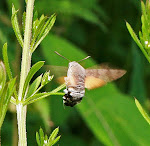These spectacular dragonflies are relatively scarce in northern England and usually found near to vegetation bordering fast-flowing streams.
.jpg)
Cumbria, however, has several localities. At this site in the south of the county, the stream is distinctly sluggish and really little more than a wide dyke passing through agricultural land. However, the banks had extensive fringing beds of vegetation (Phalaris arundinacea) amongst whose roots the larvae would have developed and on which the emerging insects often perched.
.jpg)
.jpg)
Even over just a 30 metre stretch of stream, at least six males were present but no females were seen, presumably not having emerged yet. Upstream and downstream there would no doubt be many more Demoiselles.
.jpg)
Their slow fluttering flight and bright metallic-green bodies seemed almost surreal in the bright sunlight. Males often approached each other very closely but never seemed to show hostility, quite different from many other species of dragonfly. Swallows occasionally skimmed over the stream so that the detached wing of a Demoiselle found in the water suggested that they are sometimes taken as prey.
.jpg)
.jpg)
.jpg)
.jpg)
[View upstream and downstream from the site showing the abundant fringing vegetation. Thanks to Bill Gregory for details of the locality]
.jpg)
.jpg)
.jpg)
.jpg)
.jpg)
.jpg)
.jpg)
.jpg)
.jpg)
.jpg)
.jpg)
.jpg)
.jpg)
.jpg)
.jpg)
.jpg)
.jpg)
.jpg)
.jpg)
.jpg)
.jpg)
.jpg)
.jpg)
.jpg)
.jpg)
.jpg)
.jpg)
.jpg)
.jpg)
.jpg)
.jpg)
.jpg)
.jpg)
.jpg)
.jpg)
.jpg)
.jpg)
.jpg)
.jpg)
.jpg)
.jpg)
.jpg)
.jpg)





